

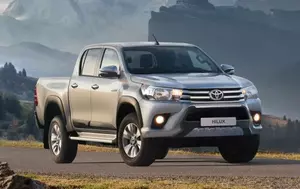
2018 Hilux Double Cab VIII (facelift 2017)

2018 Hilux Single Cab VIII (facelift 2017)

2018 Hilux Extra Cab VIII (facelift 2017)
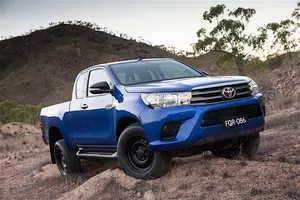
2016 Hilux Extra Cab VIII

2016 Hilux Single Cab VIII

2016 Hilux Double Cab VIII
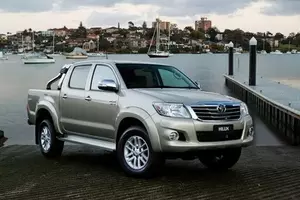
2012 Hilux Double Cab VII (facelift 2011)
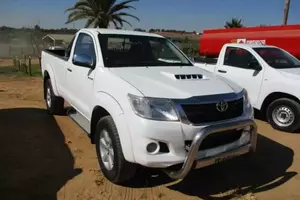
2012 Hilux Single Cab VII (facelift 2011)
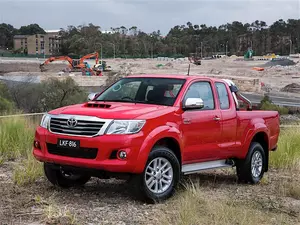
2012 Hilux Extra Cab VII (facelift 2011)

1992 Hilux Pick Up

1989 Hilux Surf

| Vehicle | Precise engine size | Difference from world average | Engine size to consumption ratio | Horsepower from 1 L | Engine size to 100 kg of weight |
|---|---|---|---|---|---|
| 2.8d |
2.76 L (2755 cc) |
17.4% bigger | - | 64 hp from 1 L | 138 cc to 100 kg |
| 2.4d |
2.39 L (2393 cc) |
2% bigger | - | 63 hp from 1 L | 133 cc to 100 kg |
| 2.7i |
2.69 L (2694 cc) |
14.8% bigger | - | 62 hp from 1 L | 150 cc to 100 kg |
| Hi-Rider 2.4d |
2.39 L (2393 cc) |
2% bigger | - | 63 hp from 1 L | 126 cc to 100 kg |
| Hi-Rider 2.8d |
2.76 L (2755 cc) |
17.4% bigger | - | 64 hp from 1 L | 145 cc to 100 kg |
| Vehicle | 2.8d |
|---|---|
| Precise engine size | 2.76 L (2755 cc) |
| Difference from world average | 17.4 bigger |
| Engine size to consumption ratio | - |
| Horsepower from 1 L | 64 hp from 1 L |
| Engine size to 100 kg of weight | 138 cc to 100 kg |
| Vehicle | 2.4d |
| Precise engine size | 2.39 L (2393 cc) |
| Difference from world average | 2 bigger |
| Engine size to consumption ratio | - |
| Horsepower from 1 L | 63 hp from 1 L |
| Engine size to 100 kg of weight | 133 cc to 100 kg |
| Vehicle | 2.7i |
| Precise engine size | 2.69 L (2694 cc) |
| Difference from world average | 14.8 bigger |
| Engine size to consumption ratio | - |
| Horsepower from 1 L | 62 hp from 1 L |
| Engine size to 100 kg of weight | 150 cc to 100 kg |
| Vehicle | Hi-Rider 2.4d |
| Precise engine size | 2.39 L (2393 cc) |
| Difference from world average | 2 bigger |
| Engine size to consumption ratio | - |
| Horsepower from 1 L | 63 hp from 1 L |
| Engine size to 100 kg of weight | 126 cc to 100 kg |
| Vehicle | Hi-Rider 2.8d |
| Precise engine size | 2.76 L (2755 cc) |
| Difference from world average | 17.4 bigger |
| Engine size to consumption ratio | - |
| Horsepower from 1 L | 64 hp from 1 L |
| Engine size to 100 kg of weight | 145 cc to 100 kg |

| Vehicle | Precise engine size | Difference from world average | Engine size to consumption ratio | Horsepower from 1 L | Engine size to 100 kg of weight |
|---|---|---|---|---|---|
| 2.4d |
2.39 L (2393 cc) |
2% bigger | - | 63 hp from 1 L | 150 cc to 100 kg |
| 2.7i |
2.69 L (2694 cc) |
14.8% bigger | - | 62 hp from 1 L | 180 cc to 100 kg |
| 2.8d |
2.76 L (2755 cc) |
17.4% bigger | - | 64 hp from 1 L | 153 cc to 100 kg |
| Vehicle | 2.4d |
|---|---|
| Precise engine size | 2.39 L (2393 cc) |
| Difference from world average | 2 bigger |
| Engine size to consumption ratio | - |
| Horsepower from 1 L | 63 hp from 1 L |
| Engine size to 100 kg of weight | 150 cc to 100 kg |
| Vehicle | 2.7i |
| Precise engine size | 2.69 L (2694 cc) |
| Difference from world average | 14.8 bigger |
| Engine size to consumption ratio | - |
| Horsepower from 1 L | 62 hp from 1 L |
| Engine size to 100 kg of weight | 180 cc to 100 kg |
| Vehicle | 2.8d |
| Precise engine size | 2.76 L (2755 cc) |
| Difference from world average | 17.4 bigger |
| Engine size to consumption ratio | - |
| Horsepower from 1 L | 64 hp from 1 L |
| Engine size to 100 kg of weight | 153 cc to 100 kg |

| Vehicle | Precise engine size | Difference from world average | Engine size to consumption ratio | Horsepower from 1 L | Engine size to 100 kg of weight |
|---|---|---|---|---|---|
| Hi-Rider 2.8d |
2.76 L (2755 cc) |
17.4% bigger | - | 64 hp from 1 L | 145 cc to 100 kg |
| 2.8d |
2.76 L (2755 cc) |
17.4% bigger | - | 64 hp from 1 L | 145 cc to 100 kg |
| 2.4d |
2.39 L (2393 cc) |
2% bigger | - | 63 hp from 1 L | 126 cc to 100 kg |
| Vehicle | Hi-Rider 2.8d |
|---|---|
| Precise engine size | 2.76 L (2755 cc) |
| Difference from world average | 17.4 bigger |
| Engine size to consumption ratio | - |
| Horsepower from 1 L | 64 hp from 1 L |
| Engine size to 100 kg of weight | 145 cc to 100 kg |
| Vehicle | 2.8d |
| Precise engine size | 2.76 L (2755 cc) |
| Difference from world average | 17.4 bigger |
| Engine size to consumption ratio | - |
| Horsepower from 1 L | 64 hp from 1 L |
| Engine size to 100 kg of weight | 145 cc to 100 kg |
| Vehicle | 2.4d |
| Precise engine size | 2.39 L (2393 cc) |
| Difference from world average | 2 bigger |
| Engine size to consumption ratio | - |
| Horsepower from 1 L | 63 hp from 1 L |
| Engine size to 100 kg of weight | 126 cc to 100 kg |

| Vehicle | Precise engine size | Difference from world average | Engine size to consumption ratio | Horsepower from 1 L | Engine size to 100 kg of weight |
|---|---|---|---|---|---|
| 2.4 D-4D |
2.39 L (2393 cc) |
2% bigger | 68 cc to 1 mpg | 63 hp from 1 L | 126 cc to 100 kg |
| Vehicle | 2.4 D-4D |
|---|---|
| Precise engine size | 2.39 L (2393 cc) |
| Difference from world average | 2 bigger |
| Engine size to consumption ratio | 68 cc to 1 mpg |
| Horsepower from 1 L | 63 hp from 1 L |
| Engine size to 100 kg of weight | 126 cc to 100 kg |

| Vehicle | Precise engine size | Difference from world average | Engine size to consumption ratio | Horsepower from 1 L | Engine size to 100 kg of weight |
|---|---|---|---|---|---|
| 2.4 D-4D |
2.39 L (2393 cc) |
2% bigger | 73 cc to 1 mpg | 63 hp from 1 L | 133 cc to 100 kg |
| Vehicle | 2.4 D-4D |
|---|---|
| Precise engine size | 2.39 L (2393 cc) |
| Difference from world average | 2 bigger |
| Engine size to consumption ratio | 73 cc to 1 mpg |
| Horsepower from 1 L | 63 hp from 1 L |
| Engine size to 100 kg of weight | 133 cc to 100 kg |

| Vehicle | Precise engine size | Difference from world average | Engine size to consumption ratio | Horsepower from 1 L | Engine size to 100 kg of weight |
|---|---|---|---|---|---|
| 2.4 D-4D |
2.39 L (2393 cc) |
2% bigger | 73 cc to 1 mpg | 63 hp from 1 L | 114 cc to 100 kg |
| Vehicle | 2.4 D-4D |
|---|---|
| Precise engine size | 2.39 L (2393 cc) |
| Difference from world average | 2 bigger |
| Engine size to consumption ratio | 73 cc to 1 mpg |
| Horsepower from 1 L | 63 hp from 1 L |
| Engine size to 100 kg of weight | 114 cc to 100 kg |

| Vehicle | Precise engine size | Difference from world average | Engine size to consumption ratio | Horsepower from 1 L | Engine size to 100 kg of weight |
|---|---|---|---|---|---|
| 3.0 D-4D |
2.98 L (2982 cc) |
27.1% bigger | 96 cc to 1 mpg | 57 hp from 1 L | - |
| 2.5 D-4D |
2.49 L (2494 cc) |
6.3% bigger | 78 cc to 1 mpg | 58 hp from 1 L | - |
| Vehicle | 3.0 D-4D |
|---|---|
| Precise engine size | 2.98 L (2982 cc) |
| Difference from world average | 27.1 bigger |
| Engine size to consumption ratio | 96 cc to 1 mpg |
| Horsepower from 1 L | 57 hp from 1 L |
| Engine size to 100 kg of weight | - |
| Vehicle | 2.5 D-4D |
| Precise engine size | 2.49 L (2494 cc) |
| Difference from world average | 6.3 bigger |
| Engine size to consumption ratio | 78 cc to 1 mpg |
| Horsepower from 1 L | 58 hp from 1 L |
| Engine size to 100 kg of weight | - |

| Vehicle | Precise engine size | Difference from world average | Engine size to consumption ratio | Horsepower from 1 L | Engine size to 100 kg of weight |
|---|---|---|---|---|---|
| 2.5 D-4D |
2.49 L (2494 cc) |
6.3% bigger | 78 cc to 1 mpg | 58 hp from 1 L | - |
| Vehicle | 2.5 D-4D |
|---|---|
| Precise engine size | 2.49 L (2494 cc) |
| Difference from world average | 6.3 bigger |
| Engine size to consumption ratio | 78 cc to 1 mpg |
| Horsepower from 1 L | 58 hp from 1 L |
| Engine size to 100 kg of weight | - |

| Vehicle | Precise engine size | Difference from world average | Engine size to consumption ratio | Horsepower from 1 L | Engine size to 100 kg of weight |
|---|---|---|---|---|---|
| 2.5 D-4D |
2.49 L (2494 cc) |
6.3% bigger | 78 cc to 1 mpg | 58 hp from 1 L | - |
| Vehicle | 2.5 D-4D |
|---|---|
| Precise engine size | 2.49 L (2494 cc) |
| Difference from world average | 6.3 bigger |
| Engine size to consumption ratio | 78 cc to 1 mpg |
| Horsepower from 1 L | 58 hp from 1 L |
| Engine size to 100 kg of weight | - |

| Vehicle | Precise engine size | Difference from world average | Engine size to consumption ratio | Horsepower from 1 L | Engine size to 100 kg of weight |
|---|---|---|---|---|---|
| 2.4 DT |
2.45 L (2446 cc) |
4.3% bigger | - | 40 hp from 1 L | - |
| 2.0 i |
2 L (1995 cc) |
15% smaller | - | 55 hp from 1 L | - |
| 2.7 i |
2.69 L (2694 cc) |
14.8% bigger | - | 57 hp from 1 L | - |
| 2.8 D |
2.78 L (2779 cc) |
18.5% bigger | - | 33 hp from 1 L | - |
| 3.0 D |
2.98 L (2975 cc) |
26.8% bigger | - | 31 hp from 1 L | - |
| 3.0 TD |
2.98 L (2982 cc) |
27.1% bigger | - | 55 hp from 1 L | - |
| 4.0 V6 VVT-i |
3.96 L (3955 cc) |
68.6% bigger | - | 62 hp from 1 L | - |
| Vehicle | 2.4 DT |
|---|---|
| Precise engine size | 2.45 L (2446 cc) |
| Difference from world average | 4.3 bigger |
| Engine size to consumption ratio | - |
| Horsepower from 1 L | 40 hp from 1 L |
| Engine size to 100 kg of weight | - |
| Vehicle | 2.0 i |
| Precise engine size | 2 L (1995 cc) |
| Difference from world average | 15 smaller |
| Engine size to consumption ratio | - |
| Horsepower from 1 L | 55 hp from 1 L |
| Engine size to 100 kg of weight | - |
| Vehicle | 2.7 i |
| Precise engine size | 2.69 L (2694 cc) |
| Difference from world average | 14.8 bigger |
| Engine size to consumption ratio | - |
| Horsepower from 1 L | 57 hp from 1 L |
| Engine size to 100 kg of weight | - |
| Vehicle | 2.8 D |
| Precise engine size | 2.78 L (2779 cc) |
| Difference from world average | 18.5 bigger |
| Engine size to consumption ratio | - |
| Horsepower from 1 L | 33 hp from 1 L |
| Engine size to 100 kg of weight | - |
| Vehicle | 3.0 D |
| Precise engine size | 2.98 L (2975 cc) |
| Difference from world average | 26.8 bigger |
| Engine size to consumption ratio | - |
| Horsepower from 1 L | 31 hp from 1 L |
| Engine size to 100 kg of weight | - |
| Vehicle | 3.0 TD |
| Precise engine size | 2.98 L (2982 cc) |
| Difference from world average | 27.1 bigger |
| Engine size to consumption ratio | - |
| Horsepower from 1 L | 55 hp from 1 L |
| Engine size to 100 kg of weight | - |
| Vehicle | 4.0 V6 VVT-i |
| Precise engine size | 3.96 L (3955 cc) |
| Difference from world average | 68.6 bigger |
| Engine size to consumption ratio | - |
| Horsepower from 1 L | 62 hp from 1 L |
| Engine size to 100 kg of weight | - |

| Vehicle | Precise engine size | Difference from world average | Engine size to consumption ratio | Horsepower from 1 L | Engine size to 100 kg of weight |
|---|---|---|---|---|---|
| 2.0 i |
2 L (1998 cc) |
14.8% smaller | - | 46 hp from 1 L | - |
| 2.4 DT |
2.45 L (2446 cc) |
4.3% bigger | - | 40 hp from 1 L | - |
| 2.7 i |
2.69 L (2694 cc) |
14.8% bigger | - | 57 hp from 1 L | - |
| 3.0 D |
2.98 L (2982 cc) |
27.1% bigger | - | 44 hp from 1 L | 157 cc to 100 kg |
| 3.0 TD |
2.98 L (2982 cc) |
27.1% bigger | - | 55 hp from 1 L | - |
| 3.0 i V6 |
2.96 L (2959 cc) |
26.1% bigger | - | 48 hp from 1 L | - |
| 3.4 i |
3.38 L (3378 cc) |
44% bigger | - | 55 hp from 1 L | - |
| 4.0 V6 24V |
3.96 L (3956 cc) |
68.6% bigger | - | 60 hp from 1 L | - |
| 4.0 V6 VVT-i |
3.96 L (3955 cc) |
68.6% bigger | - | 62 hp from 1 L | - |
| Vehicle | 2.0 i |
|---|---|
| Precise engine size | 2 L (1998 cc) |
| Difference from world average | 14.8 smaller |
| Engine size to consumption ratio | - |
| Horsepower from 1 L | 46 hp from 1 L |
| Engine size to 100 kg of weight | - |
| Vehicle | 2.4 DT |
| Precise engine size | 2.45 L (2446 cc) |
| Difference from world average | 4.3 bigger |
| Engine size to consumption ratio | - |
| Horsepower from 1 L | 40 hp from 1 L |
| Engine size to 100 kg of weight | - |
| Vehicle | 2.7 i |
| Precise engine size | 2.69 L (2694 cc) |
| Difference from world average | 14.8 bigger |
| Engine size to consumption ratio | - |
| Horsepower from 1 L | 57 hp from 1 L |
| Engine size to 100 kg of weight | - |
| Vehicle | 3.0 D |
| Precise engine size | 2.98 L (2982 cc) |
| Difference from world average | 27.1 bigger |
| Engine size to consumption ratio | - |
| Horsepower from 1 L | 44 hp from 1 L |
| Engine size to 100 kg of weight | 157 cc to 100 kg |
| Vehicle | 3.0 TD |
| Precise engine size | 2.98 L (2982 cc) |
| Difference from world average | 27.1 bigger |
| Engine size to consumption ratio | - |
| Horsepower from 1 L | 55 hp from 1 L |
| Engine size to 100 kg of weight | - |
| Vehicle | 3.0 i V6 |
| Precise engine size | 2.96 L (2959 cc) |
| Difference from world average | 26.1 bigger |
| Engine size to consumption ratio | - |
| Horsepower from 1 L | 48 hp from 1 L |
| Engine size to 100 kg of weight | - |
| Vehicle | 3.4 i |
| Precise engine size | 3.38 L (3378 cc) |
| Difference from world average | 44 bigger |
| Engine size to consumption ratio | - |
| Horsepower from 1 L | 55 hp from 1 L |
| Engine size to 100 kg of weight | - |
| Vehicle | 4.0 V6 24V |
| Precise engine size | 3.96 L (3956 cc) |
| Difference from world average | 68.6 bigger |
| Engine size to consumption ratio | - |
| Horsepower from 1 L | 60 hp from 1 L |
| Engine size to 100 kg of weight | - |
| Vehicle | 4.0 V6 VVT-i |
| Precise engine size | 3.96 L (3955 cc) |
| Difference from world average | 68.6 bigger |
| Engine size to consumption ratio | - |
| Horsepower from 1 L | 62 hp from 1 L |
| Engine size to 100 kg of weight | - |